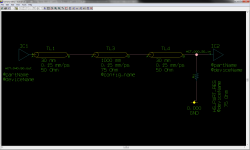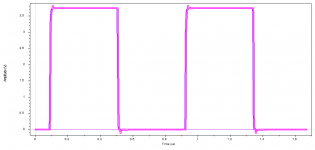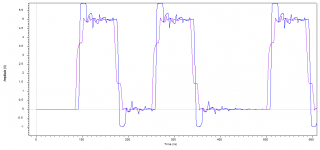Julf, I am aware that LP filters are normal, but am also aware that they are not entirely necessary
You are entitled to your opinion, and it is probably best not to divert the thread, but you are asking for technical advice after all.
All depends on what you want to measure. It is totally excessive (and "more is better" is not a rally good rule here) for audio purposes. It is totally insufficient for measuring microwave interference.For measuring purposes, would you recommend a scope of say 100MHz or higher, or is that a bit excessive?
So, again, what is it that you want to determine? If you get music out of your DAC without dropouts, then the cable works.
Julf, I am aware that LP filters are normal, but am also aware that they are not entirely necessary, and removing them from the signal path does have a sonic benefit.
True, if you define "sonic benefit" as "inaccurate reconstruction of the signal and outputting ultrasonic garbage not present in the original signal." Those filters are not just for fun and for driving up parts count, they are a crucial part of getting accurate reproduction.
I would have phrased this like:
"The DAC chip I'm certain is very good, and it's implementation is purist; i.e., no over sampling, no LP filters, hence it is very insensitive to transport and connection cable"
Jan
Correct Jan, but i'd say that "it is very sensitive to transport and connection cable" 😀
True, if you define "sonic benefit" as "inaccurate reconstruction of the signal and outputting ultrasonic garbage not present in the original signal." Those filters are not just for fun and for driving up parts count, they are a crucial part of getting accurate reproduction.
Completely agree!
Julf, I am aware that LP filters are normal, but am also aware that they are not entirely necessary, and removing them from the signal path does have a sonic benefit. But, the DAC is what it is, and fed the best signal possible, it makes a very realistic reproduction of the recorded event, the only other digital I have spent time with that rivals it (and maybe betters it in truth) is Dcs Vivaldi.
I want to emphasize in particular
it makes a very realistic reproduction of the recorded event
I'll bet that if you digitize analog records (eg vinyl) and then compare the output of a DAC without low-pass filter with original vinyl (using oscilloscope and / or spectrum analyzer) will not be identical.
This can only mean that it is not very realistic.
About such a DAC can not say that it is very realistic but can you say that sounds very pleasing to the ear.
Last edited:
i'd say that "it is very sensitive to transport and connection cable" 😀
And how do you know that?
By hearing differences..
What was your listening setup? How do you know it was the cable that caused the difference?
Correct Jan, but i'd say that "it is very sensitive to transport and connection cable" 😀
Then it's a crap DAC. You can't have it both ways.
Jan
But, the DAC is not what I want to get bogged down with here, it is getting the best signal possible to it.
With reference to my post with the SIM shots, the best way of getting a digital signal from A to B is being in control of all the aspects of that signals transmission, with a scope you can observe the waveform (don't forget to take scope loading into account) and try retro fitting some form of termination if required to help alleviate any problems.
Anyway pictures paint a thousand words blah blah blah
Below is a rough simulation of a SPDIF basic interface, signal was 12MHz, a 1m basic cable at 75 Ohms and two shorter 50 Ohm lines to mimic connectors and PCB (this is a very basic set up done on the fly). The two sims show the results with the 75 Ohms resistor to ground (Terminated) and without (un-terminated).
PS this was done in seconds and is only to illustrate how the terminating resistor will calm the over shoots, but also lower the amplitude, adding a cap to the resistor will solve this. I will do a better example later when I get a bit of time, with connectors modelled.
😀
Attachments
Last edited:
The two sims show the results with the 75 Ohms resistor to ground (Terminated) and without (un-terminated).
And what audible results would the difference correspond to? 🙂
Well, a real life signal doesn't look anything like this. You will never get square signal like this. Termination reduces the overshot sifnificantly, but doesn't make it so square.
Then it's a crap DAC. You can't have it both ways.
Jan
Jan, please, I have respect for all of you guys, a little in return would be appreciated, my ears have much experience and are the best measuring tools that i own.
But, there may be crossed wires 🙂D) please explain. For me, the dac is sensitive to cable/transport change, the sound is clearer or more muddled as an extreme description, does this fit with what you meant?
What was your listening setup? How do you know it was the cable that caused the difference?
Julf, sorry, yes it was the only part changed, so system stays as is, the cable change was made, and simply left in the system. I do not listen for differences. I feel how the music commands attention, over a period of time,maybe weeks, then swap back, feel the difference, replace again, etc etc. it is almost a subconscious way of determining 'better' or not. I have always done it like this, as consciously listening for differences can drive you mad...

I have respect for all of you guys, a little in return would be appreciated, my ears have much experience and are the best measuring tools that i own.
You are asking for advice for measuring a cable using an oscilloscope. That is an engineering activity based on science. Is it unreasonable that we ask for the same when discussing your listening experience?
So, what was your listening setup? How did you test? How did you eliminate the possibility of expectation bias? How do you know that the differences you heard were because of the cable and not some other interaction?
Julf, sorry, yes it was the only part changed, so system stays as is, the cable change was made, and simply left in the system. I do not listen for differences. I feel how the music commands attention, over a period of time,maybe weeks, then swap back, feel the difference, replace again, etc etc. it is almost a subconscious way of determining 'better' or not. I have always done it like this, as consciously listening for differences can drive you mad...
Sorry, our messages seem to have crossed! Yes, consciously listening for differences can drive you mad, but unless you have controls such as double-blind ABX in place, there is no way to isolate expectation and perceptual bias out of the equation, and they have a much more significant effect than any cable can have.
With reference to my post with the SIM shots, the best way of getting a digital signal from A to B is being in control of all the aspects of that signals transmission, with a scope you can observe the waveform (don't forget to take scope loading into account) and try retro fitting some form of termination if required to help alleviate any problems.
Anyway pictures paint a thousand words blah blah blah
Below is a rough simulation of a SPDIF basic interface, signal was 12MHz, a 1m basic cable at 75 Ohms and two shorter 50 Ohm lines to mimic connectors and PCB (this is a very basic set up done on the fly). The two sims show the results with the 75 Ohms resistor to ground (Terminated) and without (un-terminated).
PS this was done in seconds and is only to illustrate how the terminating resistor will calm the over shoots, but also lower the amplitude, adding a cap to the resistor will solve this. I will do a better example later when I get a bit of time, with connectors modelled.
😀
Marce, very interesting and a bit surprising too. how would that look at 5.6MHz? I read somewhere that terminating a short cable with a 75ohm resistor was not necessary, do you think it could help then?
I read somewhere that terminating a short cable with a 75ohm resistor was not necessary, do you think it could help then?
Not strictly necessary but won't harm either. Suggest having a look on the scope to see what effect it makes. It is unlikely to have an audible effect.
Sorry, our messages seem to have crossed!
Lol, seems so..
I consider double blind to be not so good also i'm afraid, see, music is not just about hearing, it is the emotional impact that I rely upon, and this does take time. Sometimes though, it is clear when there is a positive improvement, and it doesn't take much time at all to assess, living with it for a while can simply back up initial perception. With just swapping one item, (for me this is), I try to have no expectation or bias towards the part, ( Ive a box full of cables that I made that are rejected!) I simply accept it will either improve/ make no difference/I can't hear the difference, or has a negative effect, which has happened numerous times, thankfully never too costly though.. I thought that 'getting more scientific' would be beneficial, now i'm trying to fit the lid back on that damn can of worms though!😀
Last edited:
Jan, please, I have respect for all of you guys, a little in return would be appreciated, my ears have much experience and are the best measuring tools that i own.
But, there may be crossed wires 🙂D) please explain. For me, the dac is sensitive to cable/transport change, the sound is clearer or more muddled as an extreme description, does this fit with what you meant?
Paul I do have respect for you. But statements that things are a certain way because you heard it has already for many decades been shown as extremely unreliable, especially if you have a vested interest in the results. That is not disrespectful - that's recognising things for what they are.
There is a very good reason that audible differences are very personal. If one really wants to know if two cables sound different there's no way around a controlled test, where you exclude all clues to what the two specimens look like, their brand, their price, the opinion of your buddies, which one connected up at a certain time, etcetera.
In the overwhelming cases (but not always) those 'clear differences' disappear if all the clues except the sound are removed from the listening test. Such a result is very hard to accept as it goes against your perceptions, and it is also the reason many people try to find some unknown issue with controlled tests just to save their ego.
Jan
As to the quality of a DAC or amp or whatever: suppose I have this very expensive, very well regarded amp, that sounds like heaven to me. Now I change the line cord and the amp suddenly sounds different! You can't maintain with dry eyes that this is a competently designed amp!
If I design a regulated power supply that is 'sensitive' to the upstream rectifier diodes or reservoir cap, I've done a bad job!
If a DAC suddenly sounds different with a differnt S/PDIF cable on it's input, it's a crap DAC.
Jan
If I design a regulated power supply that is 'sensitive' to the upstream rectifier diodes or reservoir cap, I've done a bad job!
If a DAC suddenly sounds different with a differnt S/PDIF cable on it's input, it's a crap DAC.
Jan
- Home
- Source & Line
- Digital Line Level
- Is measuring square wave on spdif cable possible?


